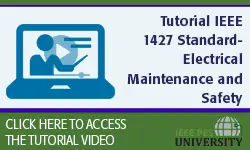-
Members: FreePES
IEEE Members: $25.00
Non-members: $40.00Pages/Slides: 61
This panel session contains the following presentations:
1. Study for the Application of Self Healing in the Overhead Low Voltage Distribution Grid
With the advancement of technology and the application of new sensors in the electrical distribution grid, in order to increase its automation, meeting the idea of smart grids, a concept that has been expanding over the years. This article describes a solution developed together with ENEL Distribution São Paulo, seeking to provide more intelligence, automatism and protection in the low voltage (LV) overhead distribution grid. A study on the methodology and application of self-healing in the LV overhead distribution grid was carried out. Self-healing is already widely used in medium voltage (MV) distribution grids, but it is not yet applied on the LV side of the distribution grid. For the application of this technology, improvements were made to the equipment called LV Control, developed in the same project with ENEL Distribution São Paulo, so that it provides the necessary subsidies for the operation of the self-healing technology in the LV electrical grid. LV Control is an equipment designed for real-time monitoring and protection of transformers in overhead distribution grids by means of motorized circuit breakers, installed on the low voltage side. Both studies, application of LV self-healing and LV Control, are part of the innovation project called "Urban Futurability". This project is located in an area with a diversity of grid types, from underground grids with high load density to overhead grids with medium load density. The application of the solution proposed in this article will be carried out in part of the overhead grid of the project region, in the city of São Paulo, Brazil.
2. A Time Domain Pilot Protection Based on Module Identification for M3C-Based Fractional Frequency Offshore Wind Power System
Fractional frequency offshore wind power system (FFOWPS) is a new type of offshore wind power system, which is proved to be more economical and has technological advantages for medium and long transmission line. Modular multilevel matrix converter (M3C) is the most expected AC/AC converter that may be used in FFOWPS. However, there is no research published about the protection for M3C-based FFOWPS. In this paper, the challenges of protection in the M3C-based FFOWPS have been analyzed, which can be summarized as follows, (i) M3C and wind turbines are all electronic devices, their intrinsic characteristics and control strategy will significantly complicate the fault characteristics, (ii) the decrease of system frequency will extend the time of phasor-based protection methods. To overcome the above challenges, the idea of model recognition is introduced in fault identification for FFOWPS based on M3C, which discriminates faults by model difference instead of comparison of voltage or current. Then, a novel time-domain pilot protection is proposed for FFOWPS based on M3C. A M3C-based FFOWPS is built in MATLAB/Simulink and the simulations have verified the adaptability of the proposed method.
3. Study on Protection Circuits for Micro-Switches in Inductive Load Control System
Micro-switches are used to control the coil of electromagnetic switches, which can control the renewable and sustainable energy distribution systems.Arc ignition of contacts is the way to dissipate energy which stored in coil inductance, so that the arc duration and erosion on contacts of micro-switches exceed expectations. Based on this, it is common to use the parallel capacitance and resistance at both pins of micro-switch as protections. In this paper, arc voltage waveform and images of a micro-switch with resistance-capacitance (R-C) protection circuit are measured. The inductance is 1.25H and the range of voltage is from 50V to 150V, and principles of the protection circuit on arc characteristics are clarified. In addition, we reveal the influence of resistance and capacitance on the protection circuit according to results. The optimal resistance and capacitance suitable for micro-switch is put forward, and protection advantages are verified by test.
4. An Imputation Reinforcement Learning Agent for Power Transformers Load Study
This paper introduces a novel imputation strategy to cope with lost factory final test results attributes values required to perform power transformers loading study. Adopting a data-driven approach, a reinforcement learning agent with little prior knowledge and using a multivariate random walks simulation of the state space is devised to navigate a thermal environment where unknown temperature rises are estimated against the normal life expectancy loading scenario. A performance evaluation of the imputation agent with a case study evidencing a natural cooled air transformer showcases prediction error within 5% range, signaling the efficacy of the imputation agent.


